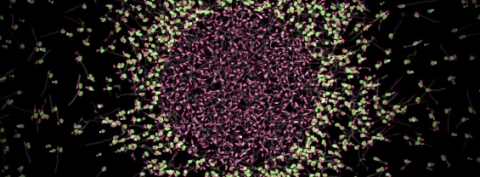Herding bacteria using computer-controlled 'sheepdogs' of light

Swimming bacteria, such as E. coli, explore space in search of better growth conditions by moving in zig-zags, where linear paths are interrupted by rapid and random reorientations.
Like cattle or sheep, if left in an open space, bacteria spread and distribute evenly if food is available everywhere. With animals, rounding-up is one of the most difficult responsibilities of ranchers and cowboys, especially when they are numerous and run fast. Researchers at the Physics Department of Sapienza University have demonstrated that computer generated light patterns can round up bacteria and “herd” them into a small, confined area. To do this, bacteria must be genetically modified to produce a protein called proteorhodopsin, a light-driven proton pump that, like a nano solar panel, uses light energy to power flagellar motors. Thanks to that, these bacteria move faster when the light is brighter and slower in darker regions. However, to round them up we must slow down only bacteria that move away from the gathering region. This can be achieved by using a computer-controlled light projector with a million tiny reflectors aimed at individual cells, so that only bacteria trying to escape can be slowed down by rapidly turning down the light.
“The implementation of our optical feedback is simple and scalable”, says Helena Massana-Cid, researcher at the Physics Department of Sapienza, “a digital camera takes pictures of a suspension of swimming cells through a microscope. These images are then processed in real time by properly designed pixel-based geometric transformations like dilations and distortions. The resulting images are projected back onto the sample after a fixed time delay so that, when swimming under this warped image of their past, thousands of bacteria flow together towards a target region. We can also move a herd of bacteria from one place to another!”
Self-propelled particles such as swimming bacteria are just one example of a much broader class of synthetic and biological non-equilibrium systems, collectively referred to as active matter. Being able to predict and control their behavior is still an ongoing challenge straddling physics and biology. Experiments such as these can add new pieces to the puzzle and offer promising insights for applications. “This research opens up many new directions for future developments in both fundamental aspects of non-equilibrium physics and applications” adds Roberto Di Leonardo, Physics Professor at Sapienza and director of the research group. “At a fundamental level, we have learnt to make a mathematical connection between the geometric properties of projected dynamical patterns and the way bacteria respond and redistribute in space. Thinking of possible applications, light could be used to trap and transport clouds of active particles within miniaturised laboratories, where their mechanical energy could be harnessed to drive biohybrid micro-machines.” The research, funded by the European Research Council, has been published in Nature Communications.
H. Massana-Cid, C. Maggi , G. Frangipane, R. Di Leonardo
“Rectification and confinement of photokinetic bacteria in an optical feedback loop”
H. Massana-Cid, C. Maggi , G. Frangipane, R. Di Leonardo
Nat Commun 13, 2740 (2022).
https://www.nature.com/articles/s41467-022-30201-1
